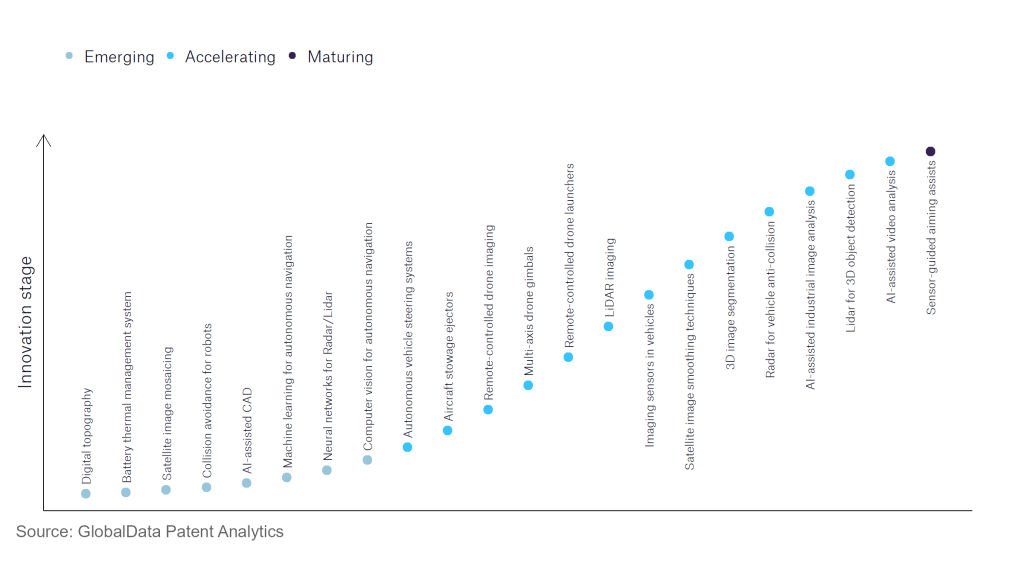The aerospace and defence industry continues to be a hotbed of innovation, with activity driven by developments in artificial technology and machine learning, and growing importance of technologies such as drones, satellite technology and big data. In the last three years alone, there have been over 174,000 patents filed and granted in the aerospace and defence industry, according to GlobalData’s report on Artificial Intelligence in Aerospace, Defence & Security: Sensor-guided aiming assists. Buy the report here.

Discover B2B Marketing That Performs
Combine business intelligence and editorial excellence to reach engaged professionals across 36 leading media platforms.
However, not all innovations are equal and nor do they follow a constant upward trend. Instead, their evolution takes the form of an S-shaped curve that reflects their typical lifecycle from early emergence to accelerating adoption, before finally stabilising and reaching maturity.
Identifying where a particular innovation is on this journey, especially those that are in the emerging and accelerating stages, is essential for understanding their current level of adoption and the likely future trajectory and impact they will have.
180+ innovations will shape the aerospace and defence industry
According to GlobalData’s Technology Foresights, which plots the S-curve for the aerospace and defence industry using innovation intensity models built on over 262,000 patents, there are 180+ innovation areas that will shape the future of the industry.
Within the emerging innovation stage, machine learning for autonomous navigation, battery thermal management system, and satellite image mosaicing are disruptive technologies that are in the early stages of application and should be tracked closely. 3D image segmentation, AV on-board control systems, and lidar for 3D object detection are some of the accelerating innovation areas, where adoption has been steadily increasing. Among maturing innovation areas is sensor-guided aiming assists, which is now well established in the industry.
Innovation S-curve for artificial intelligence in the aerospace and defence industry

Sensor-guided aiming assists is a key innovation area in artificial intelligence
Sensors can be used to improve shot accuracy for targets aimed at from handheld firearms. Multiple sensors can be linked to provide improved accuracy, and can stretch beyond the firearm itself- in training ranges the target can be linked to the weapon to further improve shot accuracy.
GlobalData’s analysis also uncovers the companies at the forefront of each innovation area and assesses the potential reach and impact of their patenting activity across different applications and geographies. According to GlobalData, there are 20+ companies, spanning technology vendors, established aerospace and defence companies, and up-and-coming start-ups engaged in the development and application of sensor-guided aiming assists.
Key players in sensor-guided aiming assists – a disruptive innovation in the aerospace and defence industry
‘Application diversity’ measures the number of different applications identified for each relevant patent and broadly splits companies into either ‘niche’ or ‘diversified’ innovators.
‘Geographic reach’ refers to the number of different countries each relevant patent is registered in and reflects the breadth of geographic application intended, ranging from ‘global’ to ‘local’.
Hvrt is one of the leading patent filers in sensor-guided aiming assists. Some other key patent filers in the aerospace and defence industry include Cubic, Raytheon Technologies and SHELTERED WINGS.
In terms of application diversity, Cubic leads the pack. Torrey Pines Logic and Sofresud stood in the second and third positions, respectively. By means of geographic reach, Sofresud held the top position, followed by Trijicon, GS Development, Komatsu and SHELTERED WINGS.
Sensor-guided aiming assists has so far had a sizeable number of patents filed by companies with a primarily commercial market focus. However, defence companies such as Hvrt, Cubic and Raytheon Technologies are also greatly contributing to the number of filed patents as they seek to expand innovation in this area. This will provide the customers of their weapon systems with the ability to fire more accurately
To further understand how artificial intelligence is disrupting the aerospace and defence industry, access GlobalData’s latest thematic research report on Thematic Research: AI in Defense.
Data Insights
From

The gold standard of business intelligence.
Blending expert knowledge with cutting-edge technology, GlobalData’s unrivalled proprietary data will enable you to decode what’s happening in your market. You can make better informed decisions and gain a future-proof advantage over your competitors.




